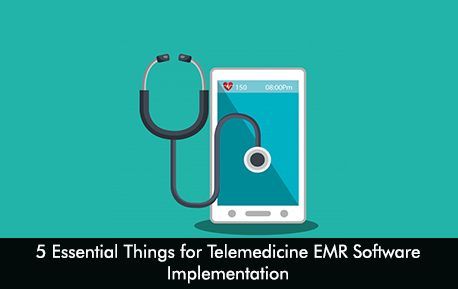Telemedicine gained immense importance due to the COVID-19 pandemic as governments and providers urged people to maintain social distance and avoid in-person hospital visits. The second wave of the virus is already hitting many countries and telemedicine EMR software remains a convenient and safe choice for patients to receive prompt remote care. The telemedicine platform provides an opportunity for healthcare providers and patients to connect via HD virtual sessions for timely diagnosis, treatment, and monitoring of various health conditions.
If your medical practice is planning to implement a telemedicine solution then these are the essential things that will be required for a smooth and successful software execution which is crucial in proving the best care to your patients in these trying times.
- Technical infrastructure – Your practice needs to make sure that you have the right technologies and facilities for the telemedicine software solution to be deployed. Your medical set-up will require uninterrupted and fast internet connectivity which will connect you to your patients seamlessly. You should have devices like smartphones, tablets, and a computer with a camera and a microphone, the hardware is necessary for the telemedicine platform to work. An integrated Electronic Medical Records (EMR) software and billing system is also needed.
- Know the options available to connect with patients – Healthcare organizations have the following three options to connect with their patients. Networked connections link up extensive healthcare facilities through the internet. The patient’s will check-in at the site of the telemedicine session. Before the telemedicine encounter starts the staff members will set up the exam room with everything necessary so time is saved. The second option available is the point to point connections which connect with larger healthcare systems through uninterrupted and high-speed internet connectivity. Remote patient monitoring is the third option which provides an opportunity for doctors and patients at home to connect for non-urgent conditions and on-going patient monitoring. The patients schedule appointments online for convenience.
- Get trained on the technology – You and your staff members must get adequate training to use the telemedicine EMR software. Usually, the software is intuitive and easy to use to offer maximum support to your practice. Check up with your telemedicine software vendor if they offer training, investing time in training will help ease implementation.
- Read up on telemedicine policies in your state – Telemedicine policies in the US vary from state to state. It is advised that you know the telemedicine policies and requirements that apply to your state. You need to research questions like, can you offer telemedicine solutions to patients outside your state? Can you write prescriptions based on the telemedicine visit? All these questions need to be addressed for you to move forward clearly.
- Create telemedicine workflows – For this, you need to meet up with your staff members to build the telemedicine workflow. Decide on how the visit will be scheduled, what preparations need to be done by the staff members before the virtual session, and do insurance verification of the patient is needed. Once the responsibilities are transparent everyone will know what to do and how to do it.
Moving ahead
Telemedicine solutions are the technological innovations that have led doctors to see greater patients and have enabled patients to receive the best care from the comfort of their homes. Telemedicine is revolutionizing healthcare for the superior quality of care.







